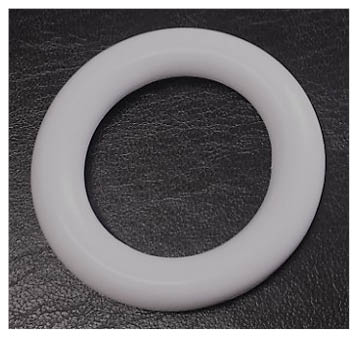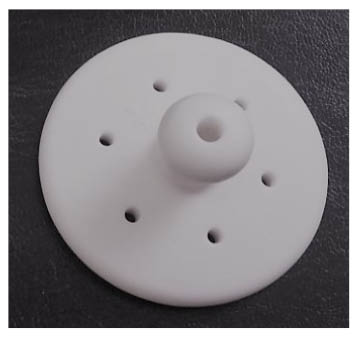Vaginal pessary for prolapse
Information for patients from Women's Health
You have been given this leaflet to answer some of the questions you may have about having a vaginal pessary fitted or changed. It explains what a pelvic organ prolapse is, the benefits and the risks of having a pessary in place, and the alternatives to pessaries.
What is pelvic organ prolapse?
Prolapse is a term that applies to any organ in the body that has moved from its original position. In gynaecology this is referred to as the altered position of the uterus (womb) and/or the vaginal walls.
What causes a prolapse?
There are a number of reasons why you may develop a prolapse.
Childbirth and pregnancy can cause damage to the supportive structures within the pelvis.
As we get older and hormone levels change at or after the menopause, alongside other genetic factors, this can weaken the pelvic floor.
If you are overweight, carry out very heavy physical work, smoke, or suffer with chronic chest conditions that cause you to cough, you will be at more risk of developing a prolapse. This is because of the additional strain these put on the muscles and ligaments of the pelvis.
What are the symptoms of a prolapse?
You may not have any symptoms and, if this is the case, treatment or surgery is not always necessary. If you do have symptoms you may feel a sensation of something coming down, a heaviness or a bulge in your vagina.
You might find it difficult to empty your bladder and/or bowel or you may find that you leak urine. You may experience a ‘dragging’ sensation in your vagina. A prolapse may also cause difficulties or pain during sex.
How is prolapse treated?
You may be able to improve your symptoms of prolapse by making lifestyle changes, such as losing weight or stopping smoking.
We recommend that you carry out pelvic floor muscle exercises, supervised by a specialist physiotherapist. We can refer you if needed. Pelvic floor exercises can help to strengthen the muscles and ligaments in your pelvis and, depending on how big your prolapse is, this may help reduce your prolapse.
A vaginal pessary may be used to relieve the symptoms of your prolapse or you may wish to consider an operation.
What is a vaginal pessary?
A vaginal pessary is a device that can be inserted into the vagina to hold a prolapsed womb and/or vaginal wall in place. Pessaries can be made of silicone or vinyl.
There are a variety of vaginal pessaries available, but the two types of pessary that we use most often are ring and shelf pessaries. You can use a vaginal pessary if you would prefer to avoid surgery, or to control your symptoms while you are waiting for surgery. You may be recommended to use a pessary if you want to have children or if surgery may not be a safe option due to your other health problems.
Ring pessary
This is round in shape and comes in different sizes. You will need a vaginal examination to decide what size you will need.
Shelf pessary
This pessary gives extra support if a ring pessary does not stay in place. You will need a vaginal examination to decide what size you will need.
-
 Ring pessary. Source: Miss Farah Lone, Consultant Urogynaecologist; Royal Cornwall Hospital
Ring pessary. Source: Miss Farah Lone, Consultant Urogynaecologist; Royal Cornwall Hospital -
 Shelf pessary. Source: Miss Farah Lone, Consultant Urogynaecologist; Royal Cornwall Hospital
Shelf pessary. Source: Miss Farah Lone, Consultant Urogynaecologist; Royal Cornwall Hospital
How is a pessary fitted?
You will have your pessary fitted by a doctor or a specialist nurse in a gynaecology clinic. They will talk to you about your symptoms and will decide with you which type of pessary is best for you.
They will carry out a vaginal examination, which will give an estimate of the size of pessary you need. It may take a few tries to get the right one.
The pessary will then be placed into your vagina and moved into place to sit behind your pelvic bone. It will take about 30 seconds to get it in and move it in to the right place. You may feel some discomfort when it is inserted but it should not be painful.
After the first fitting you will be asked to walk around for 15 to 20 minutes. This is to make sure the pessary does not fall out and that you can pass urine with the pessary in place. A properly fitted pessary should not cause any pain; if it does we will need to change the size. We may also need to fit a different size if it falls out or you cannot pass urine with it in place.
Once you feel comfortable with your pessary you can go home. You will be able to carry on with your normal daily activities without any problems.
Will I have a follow-up appointment?
We will ask you to come for a follow-up appointment six months after your pessary has been fitted. At this appointment we will check that you are happy with the pessary and change it for a new one.
Can I wear the pessary during sex?
Please talk to your doctor or specialist nurse about this. You can have sex with a ring pessary but you cannot have sex with a shelf pessary.
If you find sex with a ring pessary to be uncomfortable, we can teach you to take out your ring pessary before sex, and replace it yourself, if you would prefer. This is safe to do at home. The pessary is not a form of contraception, so please continue to use your usual method of contraception.
What are the risks of having a pessary?
It is important you report any of the following symptoms to your GP or specialist nurse.
Any difficulty passing urine.
Any change in the colour of your vaginal discharge.
Any unpleasant smelling vaginal discharge.
If your pessary falls out and you want to try another one.
If you have any bleeding from your vagina. This may be caused by the pessary rubbing and causing grazing or an ulcer in your vagina. If this happens, your pessary will have to be removed for a while (we will tell you how long), to allow the grazing to heal. We may recommend using vaginal oestrogen cream or dissolvable pessaries during this time. This will thicken your vaginal tissues and stop them from becoming dry and thin. You will be given specific instruction about this, if needed.
How often does the pessary need changing?
Your pessary normally needs changing every six months, unless you have been told otherwise.
If you have a ring pessary this may be changed by your GP or practice nurse.
If you have a shelf pessary this needs to be changed at the hospital. We will arrange an appointment for you to come and have this done. When you return to have your pessary changed we will remove your current pessary and check your vagina for grazes or any other problems, such as infection, before inserting a new pessary for you.
Before having a pessary fitted, it is important that you understand that you must agree to come to these regular appointments. If you are unable or unwilling to attend regularly, then a different way to manage your prolapse will need to be discussed and agreed with you. If you leave the pessary in for too long it can become difficult to remove, and in some cases, would need to be removed by an operation under anaesthetic; this can cause serious problems, such as infection or tissue damage.
Who do I contact if I have queries or concerns?
If you have any problems with your pessary or any queries or concerns, please contact the urogynaecology nurse specialists on:
Queen Elizabeth the Queen Mother (QEQM) Hospital, Margate
Telephone: 01843 235141William Harvey Hospital (WHH), Ashford
Telephone: 01233 651987